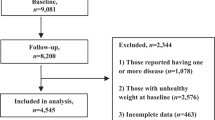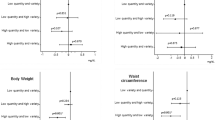Abstract
Objective: To quantify the relationship between fruit and vegetable consumption and the incidence of ischaemic heart disease.
Design: A meta-analysis of cohort studies of the relationship between ischaemic heart disease and markers of fruit and vegetable consumption, namely dietary intake of fruit, vegetables, carotenoids, vitamin C, fruit fibre and vegetable fibre, and serum concentration of carotenoids and vitamin C, adjusted for other risk factors.
Main outcome measures: Risk of ischaemic heart disease at the 90th centile of consumption relative to that at the 10th, equivalent to about a four-fold difference in fruit consumption and a doubling of vegetable consumption.
Results: The association with ischaemic heart disease was of similar magnitude for all six dietary markers of fruit and vegetable consumption. The median of the six estimates was that risk was 15% (range 12–19%) lower at the 90th centile of consumption than at the 10th. The estimates were generally adjusted for the possible confounding effect of other heart disease risk factors. The serum studies of vitamin C were consistent with this; those of carotenoids suggested a larger difference (43%) but were not adjusted for the important confounding effect of smoking. The substances in fruit and vegetables responsible for the protective effect on heart disease are uncertain but the effect is commensurate with the estimated protective effects of the potassium and folate in fruit and vegetables. Beta-carotene or vitamin E are not likely to be important because randomised trials of these vitamins in large doses have shown no reduction in heart disease mortality.
Conclusions: The risk of ischaemic heart disease is about 15% lower at the 90th than the 10th centile of fruit and vegetable consumption.
This is a preview of subscription content, access via your institution
Access options
Subscribe to this journal
Receive 12 print issues and online access
$259.00 per year
only $21.58 per issue
Buy this article
- Purchase on Springer Link
- Instant access to full article PDF
Prices may be subject to local taxes which are calculated during checkout
Similar content being viewed by others
Author information
Authors and Affiliations
Rights and permissions
About this article
Cite this article
Law, M., Morris, J. By how much does fruit and vegetable consumption reduce the risk of ischaemic heart disease?. Eur J Clin Nutr 52, 549–556 (1998). https://doi.org/10.1038/sj.ejcn.1600603
Received:
Revised:
Accepted:
Published:
Issue Date:
DOI: https://doi.org/10.1038/sj.ejcn.1600603
Keywords
This article is cited by
-
Phytochemical Composition and Potential Use of Rubus Species
Gesunde Pflanzen (2018)
-
In vitro α-glucosidase and α-amylase inhibition, and in vivo anti-hyperglycemic effects of Psidium littorale Raddi leaf extract
Research on Chemical Intermediates (2018)
-
Food sources of energy and nutrients in the diets of infants and toddlers in urban areas of China, based on one 24-hour dietary recall
BMC Nutrition (2015)
-
Fruit and vegetable consumption, ethnicity and risk of fatal ischemic heart disease
The Journal of nutrition, health and aging (2014)



